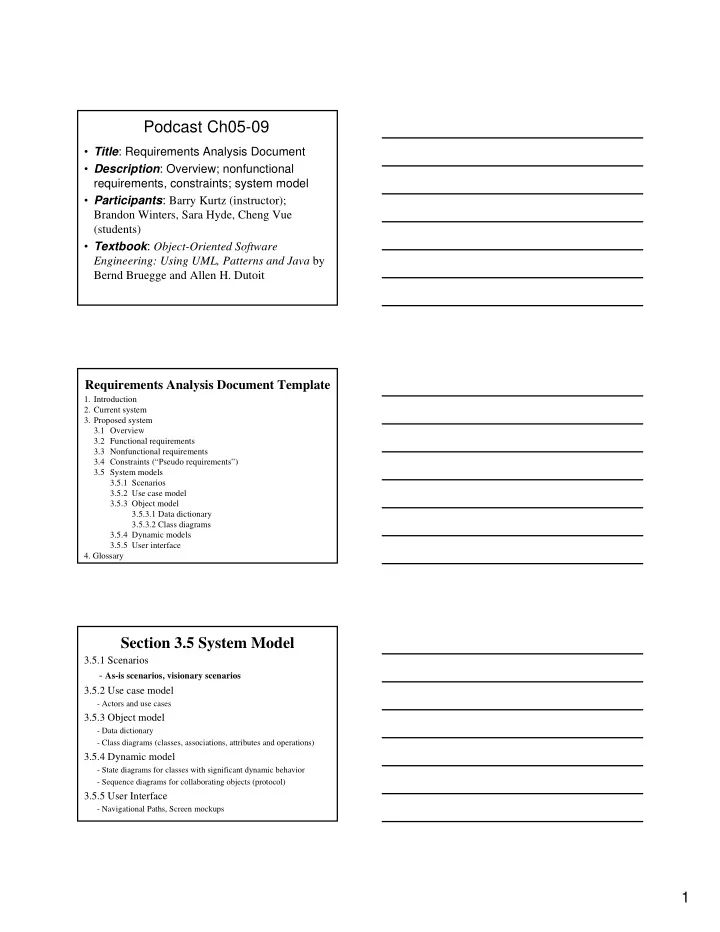

Podcast Ch05-09 • Title : Requirements Analysis Document • Description : Overview; nonfunctional requirements, constraints; system model • Participants : Barry Kurtz (instructor); Brandon Winters, Sara Hyde, Cheng Vue (students) • Textbook : Object-Oriented Software Engineering: Using UML, Patterns and Java by Bernd Bruegge and Allen H. Dutoit Requirements Analysis Document Template 1. Introduction 2. Current system 3. Proposed system 3.1 Overview 3.2 Functional requirements 3.3 Nonfunctional requirements 3.4 Constraints (“Pseudo requirements”) 3.5 System models 3.5.1 Scenarios 3.5.2 Use case model 3.5.3 Object model 3.5.3.1 Data dictionary 3.5.3.2 Class diagrams 3.5.4 Dynamic models 3.5.5 User interface 4. Glossary Section 3.5 System Model 3.5.1 Scenarios - As-is scenarios, visionary scenarios 3.5.2 Use case model - Actors and use cases 3.5.3 Object model - Data dictionary - Class diagrams (classes, associations, attributes and operations) 3.5.4 Dynamic model - State diagrams for classes with significant dynamic behavior - Sequence diagrams for collaborating objects (protocol) 3.5.5 User Interface - Navigational Paths, Screen mockups 1
Section 3.3 Nonfunctional Requirements 3.3.1 User interface and human factors 3.3.2 Documentation 3.3.3 Hardware considerations 3.3.4 Performance characteristics 3.3.5 Error handling and extreme conditions 3.3.6 System interfacing 3.3.7 Quality issues 3.3.8 System modifications 3.3.9 Physical environment 3.3.10 Security issues 3.3.11 Resources and management issues Nonfunctional Requirements: Trigger Questions 3.3.1 User interface and human factors – What type of user will be using the system? – Will more than one type of user be using the system? – What sort of training will be required for each type of user? – Is it particularly important that the system be easy to learn? – Is it particularly important that users be protected from making errors? – What sort of input/output devices for the human interface are available, and what are their characteristics? 3.3.2 Documentation – What kind of documentation is required? – What audience is to be addressed by each document? 3.3.3 Hardware considerations – What hardware is the proposed system to be used on? – What are the characteristics of the target hardware, including memory size and auxiliary storage space? Nonfunctional Requirements: Trigger Questions 3.3.4 Performance characteristics – Are there any speed, throughput, or response time constraints on the system? – Are there size or capacity constraints on the data to be processed by the system? 3.3.5 Error handling and extreme conditions – How should the system respond to input errors? – How should the system respond to extreme conditions? 3.3.6 System interfacing – Is input coming from systems outside the proposed system? – Is output going to systems outside the proposed system? – Are there restrictions on the format or medium that must be used for input or output? 2
Nonfunctional Requirements: Trigger Questions • 3.3.7 Quality issues – What are the requirements for reliability? – Must the system trap faults? – What is the maximum time for restarting the system after a failure? – What is the acceptable system downtime per 24-hour period? – Is it important that the system be portable (able to move to different hardware or operating system environments)? • 3.3.8 System Modifications – What parts of the system are likely candidates for later modification? – What sorts of modifications are expected? • 3.3.9 Physical Environment – Where will the target equipment operate? – Will the target equipment be in one or several locations? – Will the environmental conditions in any way be out of the ordinary (for example, unusual temperatures, vibrations, magnetic fields, ...)? Nonfunctional Requirements: Trigger Questions • 3.3.10 Security Issues – Must access to any data or the system itself be controlled? – Is physical security an issue? • 3.3.11 Resources and Management Issues – How often will the system be backed up? – Who will be responsible for the back up? – Who is responsible for system installation? – Who will be responsible for system maintenance? Constraints (Pseudo Requirements) • Constraint: – Any client restriction on the solution domain • Examples: – The target platform must be an IBM/360 – The implementation language must be COBOL – The documentation standard X must be used – A dataglove must be used – ActiveX must be used – The system must interface to a papertape reader 3
Exercise ch05-09-01 • Develop the nonfunctional requirements 3.3.1 through 3.3.11 for the map extension to the TRIP system • Develop any constraints for the map extension to the TRIP system • Note: You only need to submit one answer from your entire group 4
Recommend
More recommend